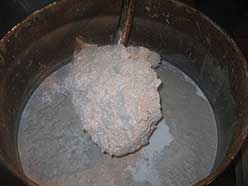Remove up to 85% of fluid from swarf and filter cake.
Separate liquid from filter cake and swarf for optimal coolant recovery and savings on material disposal costs.
Disposing hazardous grinding swarf or filter cake can be difficult and expensive. PRAB’s horizontal screw press processes material that is 40 to 50% wet with coolant or cutting oils to remove up to 85% of fluid.
Can be used as a stand-alone unit or in combination with the Dualpak™ Briquetter for coolant recovery and retainment of up to 95% of fluids.
Advantages of the PRAB Horizontal Screw Press include:
The PRAB horizontal screw press can be used as a stand-alone unit or in combination with Dualpak™ Briquetter coolant recycling systems for coolant recovery and retainment of up to 95% of fluids. Recycle fluids with one of PRAB’s fluid filtration and recycling units for even greater savings.

PRAB’s horizontal screw press processes material that is 40 to 50% wet with coolant or cutting oils to remove up to 85% of fluid.
|
|
|
RPM |
HP |
L x W x H |
|
|
SP-6 |
200 lb/hr |
5-25 |
3 |
6 x 1.2 x 2 ft |
800 lb |
|
SP-10 |
600 lb/hr |
5-20 |
5 |
9 x 2 x 3 ft |
2,000 lb |
|
SP-16 |
2,000 lb/hr |
5-20 |
10 |
13.5 x 3 x 5 ft |
5,000 lb |
Material is fed into an opening on top of the press, passing through a variable pitched auger screw and then compressed against the end plate (held in position by an air cylinder). As the material is squeezed, the extracted fluid passes through a perforated screen where it is collected for safe disposal and coolant recovery.
Material then presses against the endplate, forcing the endplate to open and allow the dewatered-material to discharge. The resistance of the endplate can be adjusted as required to enhance your fluid filtration needs.
PRAB Aluminum Swarf – Horizontal Swarf Press
PRAB’s Horizontal Swarf Press removes liquid from metal, which reduces volume and complies with environmental regulations.
PRAB Chromium Swarf – Horizontal Screw Press
PRAB’s horizontal screw press complies with environmental regulations by removing fluid up to 85 percent from the chromium.
Product Brochures
Product Brochure: Horizontal Screw Presses
White Paper
White Paper: Avoiding Accidents, Injuries & Illnesses In Metalworking Operations
White Paper: Green Engineering
White Paper: Reducing Haul-Away Costs in Metalworking Operations
Other Downloadable Content
PRAB Chip Processing Systems All Product Brochure
PRAB Builds Equipment for the Toughest Jobs in Manufacturing and Metalworking
If there is more good news to be shared about the current state of the U.S. workplace, it’s that the rate of accidents and injuries are on a healthy downward trend. However, the costs associated with these workplace injuries continue to rise, providing businesses with more financial headaches than relief. It’s not hard to see how economically devastating workplace […]
Download Proven To Reduce Metal Scrap Volume By As Much As 90% Documented Results Achieved by PRAB Customers: INCREASED REVENUE“We get $0.17 per pound more for our briquetted material over loose chips.”– Jack Rovan, Martin-Baker Plant Manufacturing Manager IMPROVED EFFICIENCY & SAFETY“PRAB has truly helped us get more money for our waste metal and improve our […]
Accidents and injuries in the workplace are going down in the US, but the costs associated with them continue to go up. There is a long way to go in reducing these costs, especially in certain areas of the metalworking industry. Fortunately, there are solutions available to decision-makers when they choose to seriously consider the application and benefits provided […]